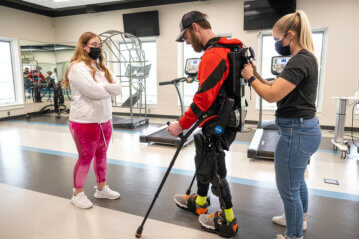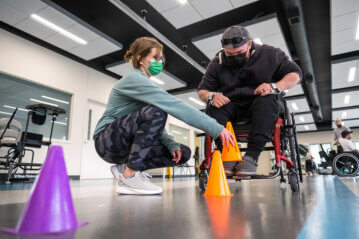If you have experienced a catastrophic injury like a brain injury, spinal cord injury, stroke, rehabilitation is a key step in helping you recover. Through various levels of care, your medical stability is monitored while rehabilitative professionals introduce exercises and practices to support your physical recovery. This helps you regain strength and functional skills with the incorporation of compensatory strategies, as needed.
Read on to learn more about the many types of rehabilitation and how your condition may benefit from therapy.
Reasons for Rehabilitation
Whether it is to address cognition, communication and/or motor skill deficits after a neurological injury or helping an individual who is living with chronic pain, there are many reasons that a person may find themselves in need of rehabilitation services.
Brain Injury
After a brain injury, a patient may struggle with strength, endurance, speech, cognitive function and motor skills. Rehabilitation therapists utilize a variety of techniques to promote neuroplasticity (the brain’s ability to recreate new pathways).
Stroke
Stroke rehabilitation is designed to help the brain relearn skills that were compromised in correlation to the part of the brain affected by the stroke. Stroke rehab usually involves:
- Motor skill exercises
- Mobility training
- Constraint-induced therapy
- Range of motion exercises
- Cognition and speech therapies
Once a patient’s condition is stable, a physician will likely recommend rehabilitation as a next step in the treatment process. The duration of stroke rehabilitation depends on the extent of the patient’s condition. This can vary quite a bit based on the severity of the stroke, the location of the brain in which the stroke occurred, and the patient’s response to therapy. Funding can also restrict the amount and length of therapy services allowed.
Chronic Pain
Once pain has reached the point of being categorized as “chronic,” research clearly shows limited benefit and many negative effects of continued opioid medication use. Rather than turning to prescription medication to manage pain, many chronic pain patients are turning to physical and occupational therapy to manage their symptoms and introduce alternative pain management and coping strategies.
Exercising to improve strength and mobility is about more than just being able to move better and lift heavier; it’s also about reinforcing the feedback loop in the brain that your body is safe and that movement doesn’t necessarily have to be accompanied by pain and discomfort. The right chronic pain therapy program should include individualized attention to empower patients to live a rich and full life.
Limb Loss
Limb loss clients require extensive rehabilitation to prevent contractures (the shortening and tightening of soft tissue close to the point of amputation), improve range of motion and learn how to transfer and adapt to functional movement. The emotional component of this type of rehabilitation is also important for the mental health outcomes of limb loss patients.
Common Types of Rehabilitation Therapies
The rehabilitation course should be customized according to the patient’s needs and goals. A client treatment plan frequently includes more than one type of therapy.
Physical Therapy
Physical therapy is therapeutic intervention. Consisting of exercises to build up strength and endurance, gait and movement, physical therapy helps get an individual back to their highest level of physical function after illness or injury. Physical therapy is useful to address situations including:
- Pain relief
- Increased movement
- Gait, mobility, and endurance
- Movement disorders
Physical therapy is an ongoing treatment that generally requires the patient to complete a home exercise program outside clinical therapy time. The client’s ability and willingness to participate and practice can yield faster and broader results.
Occupational Therapy
An occupational therapist helps individuals learn or regain the ability to perform functional tasks of the client’s every day life. These Activities of Daily Living (ADLs) may include:
- Self-care practices (grooming, using the bathroom, etc.)
- Daily tasks (cooking, cleaning, etc.)
- Vision therapy
- Driving (assessment, adaptations, etc.)
- Recreational activities
This type of therapy allows a patient to participate in the things they want and to live as independently as possible. Those with brain injuries, physical disabilities, spinal cord injuries and other physical limitations can benefit from occupational therapy.
Speech Therapy
Speech therapy provides treatment for common speech deficits including:
- Language
- Communication
- Voice
- Swallowing
- Fluency
Adults who are recovering from a stroke or brain injury can benefit from speech therapy to address aphasia, ataxia, and apraxia and other communication deficits. Regaining the ability to communicate is essential to be able to direct their own care and communicate with loved ones and caregivers.
Cognitive Rehabilitation
Cognitive rehabilitation, or cognitive-behavior rehabilitation, is a type of therapy that aims to improve memory, thinking and reasoning skills. It is often used in tandem with other therapies and under the recommendations of a neuropsychological assessment.
Cognitive approaches can include:
- Memory tasks
- Problem solving tasks
- Attention tasks
- Vulnerability assessment
Schedule an Assessment
Rehabilitation of any kind can be intimidating for those who have never experienced it before, or for those who are transitioning from a different program. We are here to answer your questions about our intensive rehabilitation program, facilities and qualifications. Our passion is your recovery.
QLI provides therapy for patients who’ve experienced brain injury, spinal cord injury, stroke, limb loss, and chronic pain. Upon assessment, you will receive a personalized treatment plan that layers in multiple types of rehabilitation to get you back to your best life.
Don’t just take our word for it—visit the campus to see for yourself. Contact us at 402-573-3748 to meet our highly dedicated team of rehabilitation professionals.
Categories: Brain Injury, Chronic Pain, Limb Loss, Neuroplasticity, Occupational Therapy, Spinal Cord Injury



